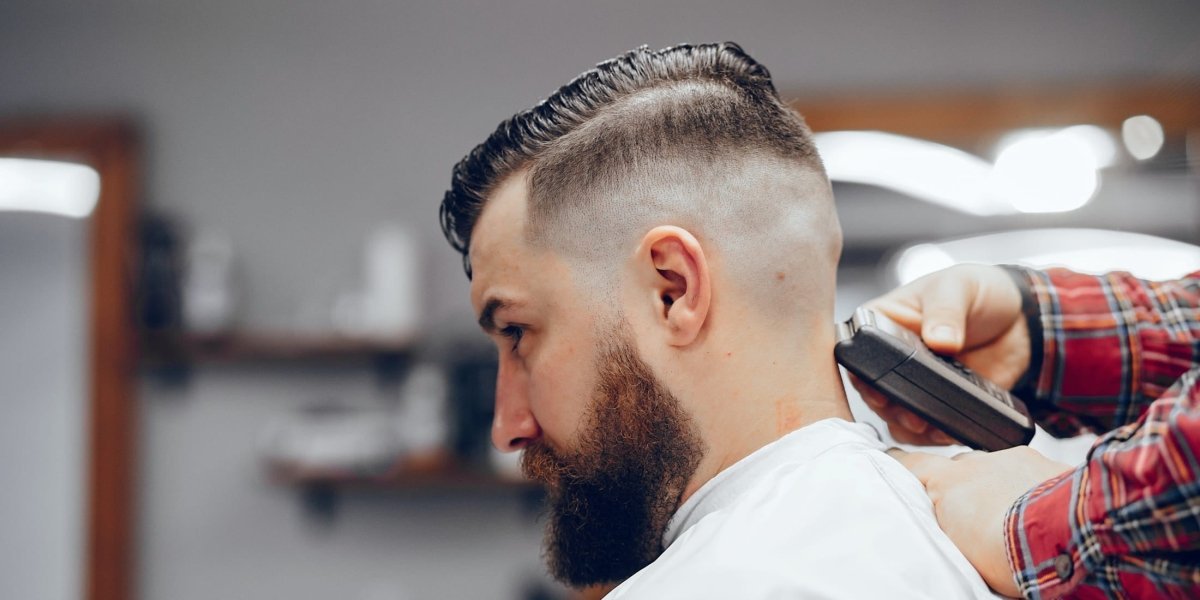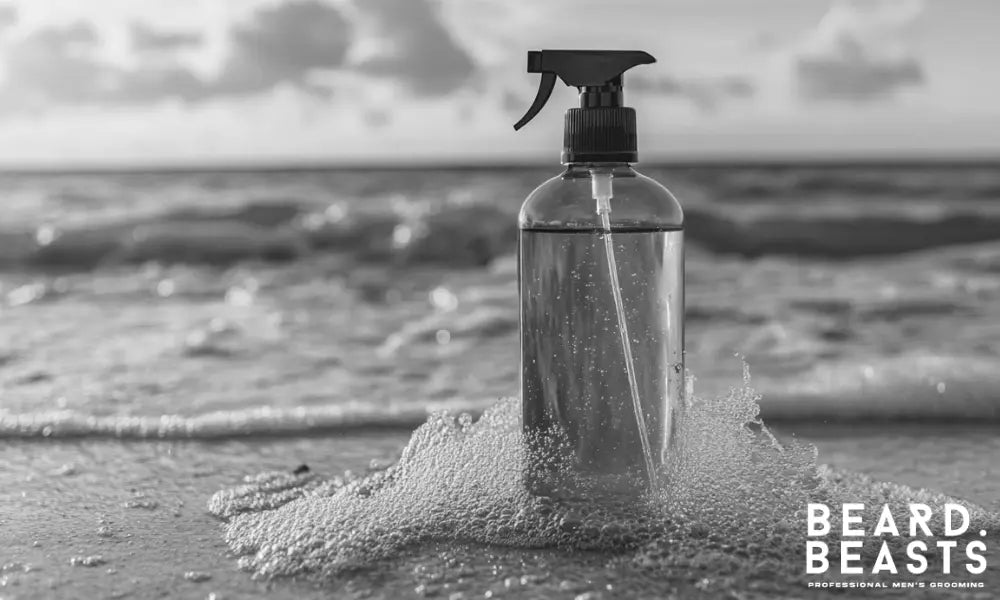Learning how to ask for an undercut can make all the difference in getting the stylish and modern look you want. The undercut is a popular hairstyle that features longer hair on top with shaved or closely cut sides and back.
It’s versatile, low maintenance, and suits various hair types and face shapes. Whether you’re inspired by celebrities, social media, or friends, preparing and communicating effectively with your barber is key.
This guide will help you understand different undercut styles, provide tips on how to describe your desired cut, and offer solutions for common issues, ensuring you achieve the perfect undercut every time.

Understanding the Undercut
An undercut is a trendy and versatile hairstyle where the hair on the top of your head is left longer while the sides and back are shaved or cut very short. This style creates a striking contrast between the longer hair on top and the shorter hair underneath, giving a clean, edgy look.
Different Types of Undercuts
There are several variations of the undercut to consider, each offering a unique twist on this popular style:
- Classic Undercut: Features a uniform length on the sides and back, with a sharp transition to longer hair on top.
- Disconnected Undercut: The hair on top is significantly longer than the sides, with no gradual fade, creating a dramatic contrast.
- Faded Undercut: The sides and back gradually taper from short to shorter, blending seamlessly with the longer hair on top.
Benefits of an Undercut
Opting for an undercut comes with several perks that make it a favorite among hairstyle enthusiasts:
- Versatility and Styling Options: An undercut can be styled in numerous ways – slicked back, combed over, spiked, or left natural. This makes it suitable for both formal and casual occasions.
- Low Maintenance: With shorter sides and back, an undercut is relatively easy to maintain. Regular trims will keep it looking sharp.
- Suitable for Various Hair Types and Lengths: Whether you have straight, wavy, or curly hair, an undercut can work for you. It’s also adaptable to different hair lengths, allowing you to experiment with different looks.
Fun Fact: The undercut has a rich history, dating back to the Edwardian era, and has seen a resurgence in popularity thanks to celebrities and influencers.
When pondering how to ask for an undercut, understanding these basics will help you communicate better with your barber, ensuring you get the exact look you desire. Remember, bringing reference photos and knowing the terminology can make all the difference in achieving the perfect undercut, which we will discuss next.
Preparing to Ask for an Undercut
Before you head to the barber, it’s essential to do some homework to ensure you get the perfect undercut. Here are some steps to help you gather inspiration:
Look for Inspiration Online
- Pinterest: Create a board dedicated to undercut styles you love.
- Instagram: Follow hairstylists and barbers who showcase a variety of undercuts. Use hashtags like #undercut, #undercuthairstyle, and #menshaircut.
- Hairstyle Blogs: Check out articles and galleries on popular hairstyle websites for the latest trends and ideas.
Save Pictures of Your Favorite Undercut Styles
- Create a Collection: Save or screenshot images of undercuts that catch your eye. This will be incredibly helpful when explaining your vision to your barber.
- Diverse Angles: Make sure to have pictures showing the front, sides, and back of the hairstyle for a comprehensive view.
Consider Face Shape and Hair Type
- Face Shape: Different undercut styles suit different face shapes. For example, a disconnected undercut can add structure to round faces, while a faded undercut works well for square faces.
- Hair Type: Whether you have straight, wavy, or curly hair, there’s an undercut that can work for you. Discuss your hair type with your barber to find the best match.
Know the Terminology
Knowing the right terms can make a big difference when asking for an undercut. Here are some key terms and concepts:
Common Terms Used by Barbers/Stylists
- Fade Undercut: A gradual transition from short to long hair. Types include low fade, mid fade, and high fade.
- Disconnected Undercut: A sharp contrast between the long top and short sides without blending.
- Taper Undercut: A gradual decrease in hair length, often used to describe the neckline or sideburns.
Understanding Clipper Lengths and Fade Types
- Clipper Lengths: Barbers use clipper guard numbers to determine hair length. Here’s a quick reference:
- #1: 1/8 inch (3 mm)
- #2: 1/4 inch (6 mm)
- #3: 3/8 inch (10 mm)
- #4: 1/2 inch (13 mm)
- Clipper Lengths: Barbers use clipper guard numbers to determine hair length. Here’s a quick reference:
Types of Fades
- Low Fade: Starts just above the ears and gradually increases in length.
- Mid Fade: Begins around the temples and works up.
- High Fade: Starts high on the head, typically above the temples.
Tip: Bringing a picture and using these terms can help your barber understand exactly what you’re looking for.
By doing your research and understanding the terminology, you’ll be well-prepared when learning how to ask for an undercut. This preparation ensures you can communicate effectively with your barber or stylist, making the entire process smoother and more satisfying.
With these insights, you’re now ready to confidently request the undercut style that suits you best!
Communicating with Your Barber
When it comes to asking for an undercut, clear communication with your barber or stylist is crucial. Here’s how to ensure you get the perfect cut:
Show Pictures of Desired Undercut Styles
- Visual Aids: Bring photos of the undercut styles you like. This helps your barber understand exactly what you’re aiming for.
- Multiple Angles: Ensure the pictures show the hairstyle from different angles (front, side, back) for a comprehensive view.
Describe What You Like About the Chosen Style
- Length: Specify how long you want the hair on top to be.
- Fade: Explain the type of fade you prefer (low, mid, high).
- Sideburns and Neckline: Discuss how you want your sideburns and neckline to be shaped.
Example: “I love this undercut style because of the high fade and longer length on top. I also like how the sideburns are tapered.”
Ask Questions
Asking the right questions can help ensure that the undercut suits your hair type and lifestyle. Here’s what to ask:
Seek the Barber’s/Stylist’s Opinion
- Suitability: “Do you think this style will suit my face shape and hair type?”
- Adjustments: “Are there any adjustments you would recommend to better match my features?”
Ask About Maintenance and Styling Tips
- Maintenance: “How often should I come in for touch-ups to keep the undercut looking fresh?”
- Styling Products: “What products would you recommend for styling my hair daily?”
- Tips: “Do you have any tips for maintaining this look at home?”
Pro Tip: A good barber or stylist will appreciate your questions and provide valuable advice tailored to your needs.
Quick Reference List:
- Length on Top: Be specific about how long you want it (e.g., 2 inches).
- Type of Fade: Low, mid, or high fade.
- Sideburns and Neckline: Tapered, squared, or natural.
By being clear, specific, and inquisitive, you’ll learn how to ask for an undercut in a way that ensures you leave the barber’s chair feeling satisfied and confident. Your barber or stylist is there to help, so don’t hesitate to communicate your preferences and ask for their expert advice.
Remember: Preparation and clear communication are key to achieving the undercut style you desire.
During the Haircut
While you’re in the chair, it’s important to stay engaged to ensure your undercut turns out just right. Here are some tips to help you monitor the process effectively:
Politely Check In During the Haircut
- Regular Feedback: Periodically check in with your barber to ensure the haircut is progressing as you imagined. A simple, “How’s it looking so far?” can go a long way.
- Mirror Checks: Use the handheld mirror to see the progress from different angles.
Communicate Any Adjustments Needed Early On
- Be Prompt: If something isn’t looking quite right, speak up immediately. It’s easier to make adjustments early in the process.
- Be Specific: Clearly explain what adjustments you’d like. For example, “Could you taper the sides a bit more?” or “I’d like the top to be left a bit longer than we discussed at the start.”
Tip: Regular communication can prevent any misunderstandings and ensure you’re happy with the final result.
Trust the Professional
Your barber or stylist is skilled and experienced, so it’s essential to trust their judgment while still ensuring your preferences are met.
Allow the Barber/Stylist to Make Minor Adjustments
- Expert Advice: Sometimes, minor tweaks suggested by your barber can enhance the overall look. Trust their expertise, especially if they recommend small changes for a better outcome.
- Flexibility: Be open to minor adjustments that might improve the hairstyle’s balance and fit.
Focus on the Result
- End Goal: Remember that the process is collaborative. The goal is to achieve a great undercut that suits you, even if some adjustments are made along the way.
- Enjoy the Experience: Relax and enjoy the experience, knowing that you’ve communicated your desires and are in the hands of a professional.
Quick Tips:
- Stay Engaged: Keep an eye on the process without micromanaging.
- Be Open-Minded: Trust the barber’s expertise while ensuring your preferences are respected.
By monitoring the process and trusting your barber, you’ll learn how to ask for an undercut and get a result you love. Balancing clear communication with professional trust is key to a successful haircut experience.
Remember: It’s a partnership. Your input combined with the barber’s expertise will result in the perfect undercut tailored just for you.
Troubleshooting Common Issues
Even with the best preparation and communication, there might be times when the undercut doesn’t turn out as you envisioned. Here’s how to handle it:
How to Communicate Your Concerns with Your Barber/Stylist
- Be Honest and Polite: Express your concerns calmly and clearly. For example, “I was hoping for a shorter fade on the sides.”
- Specific Feedback: Point out specific areas that need adjustment. Avoid vague comments; instead, say something like, “Could you blend this part more?”
Possible Solutions
- Minor Adjustments: Often, small tweaks can fix the issue. Ask your barber if they can make the necessary changes.
- Follow-Up Appointment: If a significant change is needed, schedule a follow-up appointment.
- Growing Out: If you’re still unhappy, consider growing out the undercut and trying a different style next time.
Tip: Most barbers want you to leave satisfied and will appreciate constructive feedback.
Growing Out an Undercut
If you decide to move on from the undercut, here are some tips to transition smoothly to another hairstyle:
Tips for Transitioning from an Undercut to Another Hairstyle
- Regular Trims: Keep the top trimmed while the sides grow out to maintain a balanced look.
- Gradual Blending: Ask your barber to blend the growing sides with the top gradually to avoid a stark contrast.
- Patience: Growing out a haircut takes time, so be patient and focus on maintaining a neat appearance during the process.
Styles That Work Well During the Grow-Out Phase
- Textured Crop: A shorter, textured style can help blend the different lengths.
- Side Part: As the hair grows, a classic side part can keep your hair looking stylish and tidy.
- Messy Quiff: Embrace a more relaxed look with a messy quiff, which can help hide uneven growth.
Quick Tips:
- Stay Consistent: Regular maintenance cuts are key to managing the grow-out phase.
- Use Styling Products: Products like pomade or wax can help control and style your hair during the transition.
Fact: Growing out an undercut can take a few months, so having a plan and sticking to regular trims will make the process smoother.
By knowing how to ask for an undercut and addressing any issues promptly, you can ensure you always leave the barber’s chair happy. And if you ever want to switch up your look, these tips will help you transition seamlessly.
Remember: Communication is key, whether you’re fixing an issue or growing out your undercut. Your barber is there to help you achieve the best possible look, so don’t hesitate to share your concerns and preferences.
Frequently Asked Questions (FAQs)
How do you describe an undercut to a barber?
Describing an undercut to your barber is all about clear communication. Here’s how to do it effectively:
- Show Pictures: Bring photos from different angles to provide a clear visual reference.
- Specify Lengths: Mention how long you want the top, sides, and back to be.
- Detail the Fade: Explain the type of fade you prefer – low, mid, or high.
- Highlight Key Features: Describe any specific features like sideburns, neckline, or if you want it disconnected.
Example: “I want a disconnected undercut with a high fade. Keep the top around 3 inches long and taper the sideburns.”
What face shapes are best suited for an undercut?
Undercuts can be versatile and suit various face shapes, but some styles complement specific shapes better:
- Round Faces: A high fade with longer top adds height and elongates the face.
- Square Faces: A classic undercut softens the angles and adds balance.
- Oval Faces: Most undercut styles work well with this versatile face shape.
- Heart-Shaped Faces: A low to mid fade with some length on top can balance the broader forehead and narrower chin.
Fact: The right undercut can enhance your facial features and provide a balanced look.
Can an undercut work with curly or wavy hair?
Absolutely! An undercut can look fantastic with curly or wavy hair. Here’s how to make it work:
- Embrace Texture: The natural volume and texture can add a unique twist to the undercut.
- Choose the Right Length: Keep the top long enough to showcase the curls or waves.
- Maintenance: Regular trims and appropriate styling products help manage the curls.
Tip: Discuss your hair type with your barber to find the best undercut variation for you.
How do I maintain the undercut if I’m growing it out?
Growing out an undercut requires some patience and regular care. Here’s how to do it:
- Regular Trims: Keep the top trimmed and blend the sides as they grow.
- Use Products: Pomade, wax, or gel can help style your hair during the transition.
- Styling Techniques: Try styles like a side part or textured crop to manage the different lengths.
Example Routine:
- Trim Frequency: Every 4-6 weeks.
- Products: Light pomade for a natural hold.
Fact: Maintaining a neat appearance during the grow-out phase makes the process smoother and more stylish.
What products are best for styling an undercut?
The right products can enhance and maintain your undercut. Here are some top picks:
- Pomade: Provides a medium to high hold with a shiny finish. Great for slicked-back styles.
- Wax: Offers a strong hold with a matte finish. Ideal for textured looks.
- Gel: Gives a firm hold and wet look. Suitable for more structured styles.
- Clay: Delivers a natural look with a strong hold. Perfect for messy, tousled styles.
Product Chart:
| Product | Hold | Finish | Best For |
|---|---|---|---|
| Pomade | Medium-High | Shiny | Slicked-back styles |
| Wax | Strong | Matte | Textured looks |
| Gel | Firm | Wet | Structured styles |
| Clay | Strong | Natural | Messy, tousled styles |
Tip: Experiment with different products to find the one that best suits your hair type and desired style.
By addressing these FAQs, you’ll gain a deeper understanding of how to ask for an undercut and maintain it. Whether you’re communicating with your barber, growing out your style, or finding the perfect product, these insights ensure you achieve the best results.
Concluding How To Ask For An Undercut
Getting the perfect undercut is all about preparation, communication, and a bit of patience. Here are the key takeaways from our guide:
Understand the Undercut
- Definition: Longer hair on top, short sides and back.
- Types: Classic, disconnected, and faded undercuts.
- Benefits: Versatile, low maintenance, and suitable for various hair types.
Prepare to Ask for an Undercut
- Research: Find inspiration on Pinterest, Instagram, and hairstyle blogs.
- Save Pictures: Bring photos of your favorite styles.
- Know the Terminology: Learn common terms and clipper lengths.
Communicate with Your Barber/Stylist
- Be Clear and Specific: Show pictures and describe what you like.
- Ask Questions: Get your barber’s advice on what suits you and ask about maintenance tips.
During the Haircut
- Monitor the Process: Check in and communicate any adjustments early on.
- Trust the Professional: Allow your barber to make minor adjustments for the best result.
Troubleshooting Common Issues
- If Unsatisfied: Express your concerns clearly and ask for possible fixes.
- Growing Out: Use regular trims and styling techniques to manage the transition.
Final Thoughts
Learning how to ask for an undercut and understanding the process can significantly enhance your hairstyle experience. By doing your research, communicating clearly with your barber, and knowing how to troubleshoot common issues, you’ll achieve a stylish and satisfying undercut.
Remember: Confidence in your communication and trust in your barber’s expertise are key to getting the perfect undercut. Enjoy your new look and the versatility it brings!
Feel free to share your undercut experiences and tips in the comments. We’d love to hear how you style and maintain your undercut!





